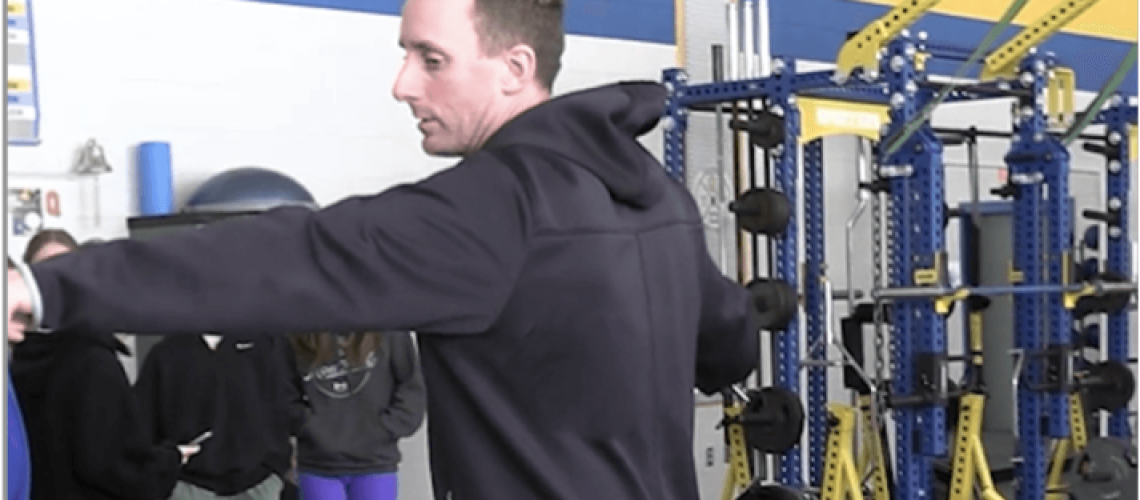Developing, Implementing and Monitoring Power using VBT
By John Martin, CSCS
Power is defined in the world of physics as the rate of doing work. Using the basic formula that we all learned at the foundational level of rudimentary physics, Power = Work/Time. How fast can one do work? Isn’t this what we all look for in any sport? Even with the greatest of endurance events, your ability to accomplish your “work” in the shortest time is always the goal.
Using this thought process, Power is Sport. And without power, sport is not as captivating and/or the athletes are not as capable as we would desire. If this is the case, why don’t we focus on power more when it comes to training? Why do we find ourselves so captivated by the strength numbers that athletes put up in pounds vs. measuring our athletes output in wattage? In order to even go down this “Alice in Wonderland” rabbit hole, we first need to shift our paradigm of thought. This has already begun to occur at all levels of performance, thanks to the development of weight room technology. But before this pendulum swings too far one way, let’s get to the root of how we can look at power with high school athletes and what it all means.
Power Development:
In order to develop power, strength must first exist. Creating a solid frame and foundation are key to unlocking the power potential of athletes. I would also argue that on a greater note, foundational strength ensures that our athletes are utilizing their potential power while avoiding injury. You cannot equip a V-8 NASCAR car motor on a Saturn ION frame; the engine would create so much torque that it would cause physical damage to the automobile itself. This also exists within humans. Our structural frame must be able to withstand the power output we are looking for. We can go into a whole new article on how the brain will down regulate the power output, almost like a governor on a car, if there are leaks in the power system.
As coaches, we work through basic movement efficiency, the strength generated through those movements and progress this throughout the young adolescence of our athletes’ training experience. We must stick to the essentials of movement and become proficient in these, as well as strong throughout the movements.
Power Implementation:
Once the above is established, we can then look at how we begin to implement power within our training programs to optimize performance. I also want to preface that performance is all about what the athletes do within their “field” of play. Our goal is to maximize power potential so that our athletes can begin to unlock this potential within their sport. This can be accomplished in a variety of ways, and the twitter verse can be eye-opening to how many people think that is either Olympic lifting, or no Olympic lifting. Once again, a conversation for another time. But we must look at the energy system needs of our athletes, the demand of their sport and how this translates biomechanically as well as physiologically. For example, if you are working with a basketball or volleyball athlete, their program has to be more about vertical power and short linear/lateral bursts. Sports like baseball, softball, lacrosse and field hockey start to really hit on rotational power generation.
So understanding that the sport can translate to the weight room and how we look to implement power. Now this does not mean excluding all other aspects of the foundations we touched upon, but there has to be a focus in terms of creating power in certain planes and through certain movements.
Power Monitoring:
Now comes the fun part in our profession in the 21st century. How do we begin to transition out of the “strength is absolute” thinking into the mindset of Power for Performance? This begins by giving student-athletes, coaches and parents the data they need to measure. Strength is all about measuring, which is why we have used it for years. Strength has been absolute because it is quantifiable. Strong or not strong.
Through today’s world of technology, companies such as Output sports can supply a strength coach with all they need to begin this process for their athletes. By using technology to generate data around mean or peak power, mean or peak velocity, relative force, total work etc., we can look at what our athletes are doing every single rep in such depth when it comes to power. Though we can begin to measure and compare, we must ensure that we are, most importantly, monitoring and evaluating.
Understanding that data that can be derived and how to use it objectively is key with our athletes. Using Velocity Based Training, we can build a solid base of strength and movement, begin to use certain programmable movements and assessments, and then do just that. Assess. Monitor. Evaluate. Using programs such as Output can help us do this on a daily basis from wellness check-ins, to peak power output on a single leg, to a rotational stability assessment.
This can ensure that all those who cross the threshold into our shrines as high school strength coaches should be coveted, as our role is to build that frame and engine through the most crucial time in human development. This will and has moved the needle in the right direction for our field, but it is up to us to ensure that our communities are educated to optimize our athletes’ potential efficiently and safely.
John Martin is Sports Performance Coordinator at Queensbury HS in New York for the last 6 years, overseeing all athletic programs 9-12. Prior to Queesnbury, he spent 5 years as a Head Varsity Football coach after completing his internship at Duke University in their sports performance department. He has served as the New York State Director director for the NHSSCA over the past 2 years.


